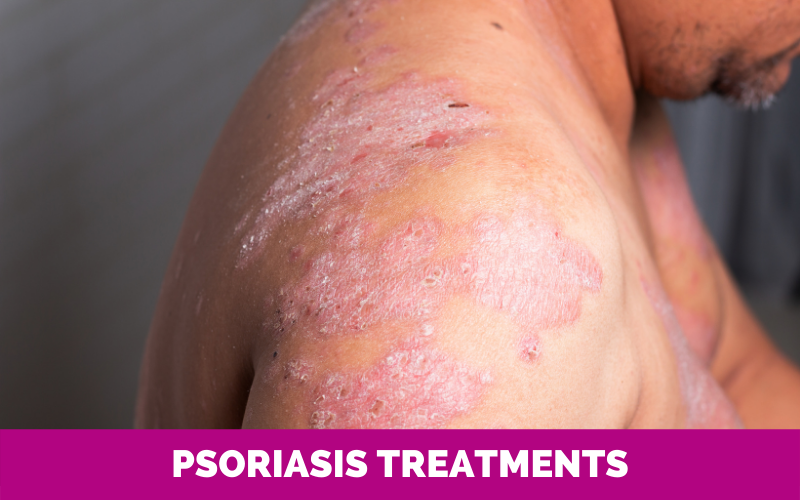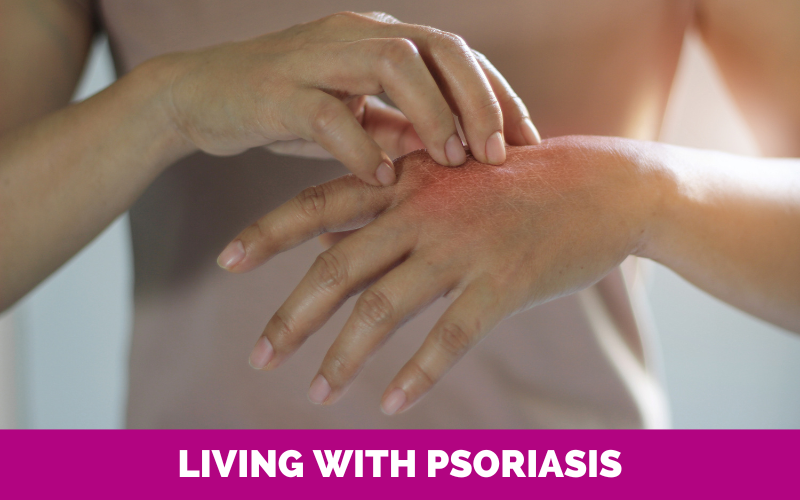Autoimmune Conditions
Psoriasis Comorbidities
The umbrella term “spondyloarthritis” (SpA) refers to the types of autoimmune arthritis that affect both the joints and the entheses (the points where ligaments and tendons attach to bones). The term can be loosely translated as a type of arthritis capable of producing “inflammation of the joints of the spine” as well as the peripheral joints and specific organs.
SpA commonly develops before the age of 40, although diagnosis can take up to 10 years. It is believed that roughly 0.5 to 2 percent of the global population have some form of this condition.5
People with SpA don’t test positive for rheumatoid arthritis biomarkers, however, many have the gene called HLA-B27. Some people with this gene do not develop SpA and some with spondyloarthritis don’t have the HLA-B27 gene.
SpA can be divided into three main subcategories. These share many symptoms but have key distinctions.
- Axial spondyloarthritis (axSpA): This predominantly affects the axial skeleton (the spine, hips and the sacroiliac joints – the joints on either side of the lower spine that connect it to the pelvic bone). In moderate to severe cases, prolonged inflammation can cause joints to fuse, affecting posture and joint mobility. AxSpA can be further subdivided into “radiographic” and “non-radiographic” forms. Radiographic axial spondyloarthritis is more commonly known as ankylosing spondylitis.
- Peripheral spondyloarthritis (pSpA): This predominantly affects the peripheral joints such as those in the hands and feet and may include the organs such as the skin. Examples of pSpA include psoriatic arthritis, reactive arthritis and enteropathic arthritis (related to inflammatory bowel disease).
(See below for more information about psoriatic arthritis.) - Undifferentiated/unclassified spondyloarthritis (uSpA): This term is used to describe signs and symptoms of a person who does not meet the criteria for a definitive diagnosis of either axial or peripheral spondyloarthritis. In some cases, people with uSpA will develop a more well-defined form of spondyloarthritis over time.
(Learn more about axial spondyloarthritis in our free resource, A Patient’s Guide to Living with Axial Spondyloarthritis in Australia.)
Anyone can get psoriatic arthritis (PsA) but it is most common in adults, affecting men and women equally.2 In Australia, psoriatic arthritis affects an estimated 30 per cent of individuals living with psoriasis.3
Most people who get this disease already have psoriasis, although some people develop PsA first. On average, psoriatic arthritis develops about 7 to 10 years after the beginning of skin symptoms.2 In some cases, people get joint pain symptoms before psoriasis skin plaques show up. Some people with PsA may have more intense arthritis but less psoriasis, while others may have mainly psoriasis without serious joint problems.
Common symptoms of PsA include:
- Swollen fingers and toes: Red, tender, painful swelling (dactylitis) that causes “sausage-like” toes and fingers
- Painful joints: Achy, stiff joint pains (typically in hands, knees and ankles and on one side of the body) or inflammation in the joints of the spine (axial involvement)
- Enthesitis: Inflammation of the entheses, or where a tendon or ligament attaches to the bone, causing symptoms such as Achilles tendonitis or plantar fasciitis
- Nail changes: Pitting, thickening, ridging (Beau’s line) or crumbling of the nail; color changes; onycholysis (separation from the nail bed); subungual (debris under the nail)
To diagnose PsA, doctors look at the patient’s history, physical symptoms and imaging test results. There is no specific blood test for PsA, however, testing for similar conditions such as rheumatoid arthritis may help the process of elimination.
Rheumatoid arthritis (RA) is the most common form of autoimmune arthritis, affecting approximately 514,000 Australians.4 It is more common in women than men and can strike at any age, although it usually begins between the ages of 40 and 60.
In RA, the immune system attacks the lining of the joints, which damages the tissue that covers the ends of the bones in a joint. It often affects the small joints of the hands and feet first, however, it can occur in any joint. RA can also affect other areas of the body, such as the heart, lungs, blood, nerves, eyes and skin.
Common symptoms of RA include:
- Joint pain, swelling or redness: Often in corresponding joints on both sides of the body
- Morning stiffness: Joint stiffness that lasts over an hour, especially after sitting or resting for a while
- Rheumatoid nodules: Swollen bumps under your skin around your joints
Prolonged inflammation from RA can cause patients to develop holes or “erosions” in the bones around the joints. The damaged caused by these erosions can cause a progressive loss of the ability to function and possible fusion.
With RA, diagnosis involves a medical history, physical examination, blood tests and imaging studies. Blood tests look for levels of inflammation in the body and the presence of specific biomarkers (rheumatoid factor and anti-CPP) that indicate an increased likelihood of RA. However, it is possible to have these biomarkers and not have RA. It is also possible to have seronegative RA (a form that has the clinical symptoms but not the biomarkers).
(Learn more about RA in our free resource, A Patient’s Guide to Living with Rheumatoid Arthritis in Australia.)
Inflammatory bowel disease (IBD) is an umbrella term for a group of autoimmune conditions that cause ulcers and inflammation of the tissues in the gastrointestinal tract. In IBD, the immune system attacks tissue within this tract.
The two main IBD conditions are:
- Crohn’s disease: Affected areas can include any part of the gastrointestinal tract from the mouth to the anus, including all of the layers of the bowel wall.
- Ulcerative colitis: Affected areas are limited to the colon or large intestine. Inflammation only affects the inner lining of the bowel wall.
IBD is estimated to affect nearly 180,000 Australians. Most new IBD diagnoses appear in adolescence and young adulthood but it can affect people of all ages.6
Common symptoms of IBD include:
- Diarrhea
- Nausea
- Belly pain and cramping
- Urgent and/or more frequent bowel movements
- Faecal incontinence
- Blood in the stool
- Anaemia (from loss of blood through the stool)
- Loss of appetite
- Losing weight without trying
- Malnutrition
Prolonged inflammation from IBD can damage the intestines and cause:
- Abscesses: Pockets of infection that can result in tearing of the intestinal wall.
- Strictures: Areas of narrowing in the bowel.
- Fistulas: Abnormal passageways between two organs or vessels that normally do not connect. Fistulas happen when inflammation and pressure inside the bowel break down tissue, and can cause bowel contents to leak into the bladder, urethra or vagina.
- Long-term inflammation in the colon increases the risk of colon cancer.7
Diagnostic tests and procedures for IBD include:
- Blood tests for inflammation and anaemia
- Stool samples
- Imaging tests to screen for signs of inflammation, obstructions or damage
- Internal examinations (such as colonoscopies and endoscopies) using tiny cameras attached to thin, flexible tubes inserted into the body via small incisions
Researchers believe there are between 80 and 150 autoimmune conditions (including psoriasis).1
Autoimmune conditions result from dysfunctions within the immune system that cause it to mistakenly attack healthy cells instead of real threats. The areas of the body affected can help doctors to diagnose the condition. For example, forms of autoimmune arthritis affect the joints while forms of lupus affect the organs. However, many can be difficult to diagnose.
Common symptoms of autoimmune conditions include general body aches and flu-like symptoms, occasional fevers and a loss of appetite. Fatigue and cognitive dysfunction (or “brain fog”) are perhaps the most common symptoms. This is because overactive immune systems use a lot of energy, leaving less for everyday activities.
In most cases, these conditions result from a combination of genetic and environmental influences, such as pathogens and hormonal triggers, especially in individuals with a genetic predisposition. People with one autoimmune condition have an increased risk of developing others.
Symptoms can range from mild to severe and vary over months, days or even hours. There is no cure for autoimmune conditions and they can cause severe, irreversible damage, especially if not treated early.
Complementary medicines, pain treatments and lifestyle changes can help symptoms but they don’t affect disease progression. However, there are many conventional treatments available that can suppress the immune system, slow disease development, reduce symptoms and allow people with these conditions to live full and active lives.
Helpful resources
International resources






